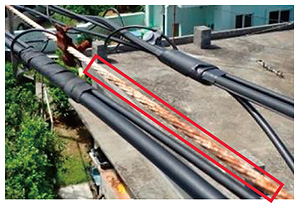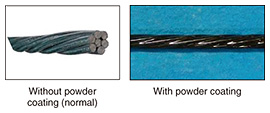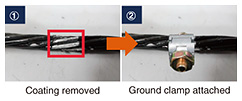 |
|||||||||||||||||
|
|
|||||||||||||||||
|
Practical Field Information about Telecommunication Technologies Vol. 22, No. 4, pp. 58–61, Apr. 2024. https://doi.org/10.53829/ntr202404pf1 Precautions for Installing and Repairing
|
|||||||||||||||||
| *1 | Universal band: A metal band that wraps around a utility pole and is used as a base for attaching various metal fixtures. |
| *2 | Dead-end grip: A twisted steel rope that wraps around a messenger wire when it is strung to a utility pole. |
| *3 | Suspension clamp: A metal fixture attached to a universal band to grip and secure a messenger wire. |
| *4 | Messenger-wire crossing fixture: A fixture for securing messenger wires that cross in mid-air. |
3. Precautions during repair
3.1 Necessity of repair and repair materials
The powder coating and hot-dip-galvanizing applied to messenger wires and surrounding fixtures can become scratched or peel off due to various factors during installation. Damage to the powder coating and galvanized plating will shorten the lifespan of the entire messenger wire, so it is necessary to repair the damaged area by using a method appropriate for the area to restore corrosion resistance.
One repair method is to apply an anti-corrosion coating to the damaged area of the messenger wire. With on-site application of anti-corrosion coating, it is difficult to ensure an even distribution of coating thickness over long distances, and there is a risk of paint splattering, but it can be used as a localized repair method. Two types of coatings are available: liquid [3] and spray [4]. Although the liquid type has excellent corrosion resistance, it must be applied with a brush, so it is difficult to sufficiently apply it to confined spaces. For that reason, it is recommended to repair by applying the liquid type with a brush for open areas, such as the surface of messenger wires where no fixtures are attached, and by using the spray type in confined spaces, such as the fastening points of fixtures.
3.2 Precautions for each repair location
Example locations of repairs to a powder-coated messenger wire are shown in Fig. 5. The repair methods and precautions for each repair location are explained as follows.
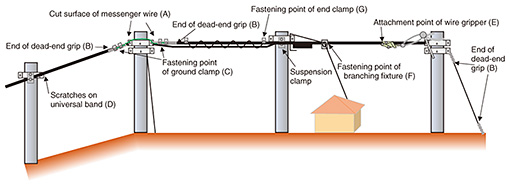
Fig. 5. Example of locations where powder-coated messenger wire is repaired.
3.2.1 Cut surface of messenger wire and end of dead-end grip
The cut surface of messenger wire (Fig. 5(A)) and the end of the dead-end grip (Fig. 5(B)) are prone to damage to the coated and plated surfaces owing to impact during cutting and metal-to-metal contact. Since these locations are open areas and relatively easy to repair, repair by applying a liquid-type coating with a brush is recommended.
3.2.2 Fastening point of ground clamp
As explained in Section 2.2.2, when a ground clamp (Fig. 5(C)) is attached to a messenger wire, the coating is removed with a tool such as pliers to ensure conductivity. After the ground clamp has been fastened, the area where the coating has been removed must be repaired to prevent corrosion. For confined spaces such as the gaps between clamps, where it is difficult to apply a liquid-type coating with a brush, it is recommended to apply a spray-type coating. When repairing by spray, it is advisable to fasten the bolt of the ground clamp and spray from upwind to prevent the person who is spraying from inhaling the spray. Measures must also be taken to prevent the spray from dispersing into private houses or dripping onto the ground.
3.2.3 Scratches during attachment of universal band
When attaching a universal band (Fig. 5(D)), an operator uses a hammer to fit the band to the pole, but it is recommended to use a resin hammer instead of a normal (metal) hammer because a metal hammer may damage the coated surface of the band. As shown in Fig. 6, even a resin hammer can peel of the coating due to the impact of striking, so any peeled areas should be repaired by re-applying the coating by brush.
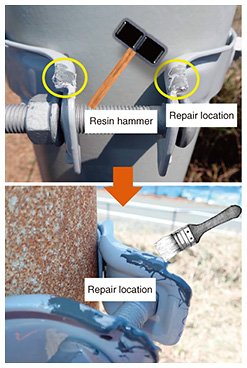
Fig. 6. Method of repairing universal band.
3.2.4 Fastening points of wire gripper, branching fixture, and end clamp
At the fastening points of a wire gripper (Fig. 5(E)), branching fixture (Fig. 5(F)), and end clamp (Fig. 5(G)), the tightening force will cause scratches and dents on the coated surface of the messenger wire. To repair that damage, it is recommended to apply a liquid-type coating to the area where the wire gripper was installed and apply a spray-type coating to other areas (i.e., confined spaces) in the same manner as for the ground clamp.
4. Conclusion
To protect telecommunication equipment and facilities from corrosion caused by environmental effects such as salt damage, it is effective to apply a strong corrosion-prevention powder coating; however, it is necessary to consider certain points of note in the design and installation of powder-coated equipment that do not apply to normal processes. By paying attention to these points and carrying out appropriate installation and repair, the excellent anti-corrosion performance of a coated surface will be manifested, and the lifespan of the coated equipment will be extended to the full.
TASC will continue to engage in technical cooperation to solve problems in the field, such as issues related to equipment and facility deterioration due to salt damage and other types of corrosion, and contribute to improving the quality and reliability of telecommunication services.
References
| [1] | Technical Assistance and Support Center, NTT EAST, “Salt Damage in RT-BOXes: Investigation and Countermeasures of Salt-damage Environments,” NTT Technical Review, Vol. 20, No. 6, pp. 52–56, June 2022. https://doi.org/10.53829/ntr202206pf1 |
|---|---|
| [2] | Website of Zentsukyo, NTT Specification Product List (in Japanese). https://www.zentsukyo.or.jp/product-list/product-ntt-list |
| [3] | Website of ACCESS, RUSTAFF 2100 Series (in Japanese). http://www.access-orbit.co.jp/anticorrosion/index_f.html |
| [4] | Website of ROVAL, ROVAL Cold Galvanizing Compound. https://rovalworld.com/products/roval/ |









